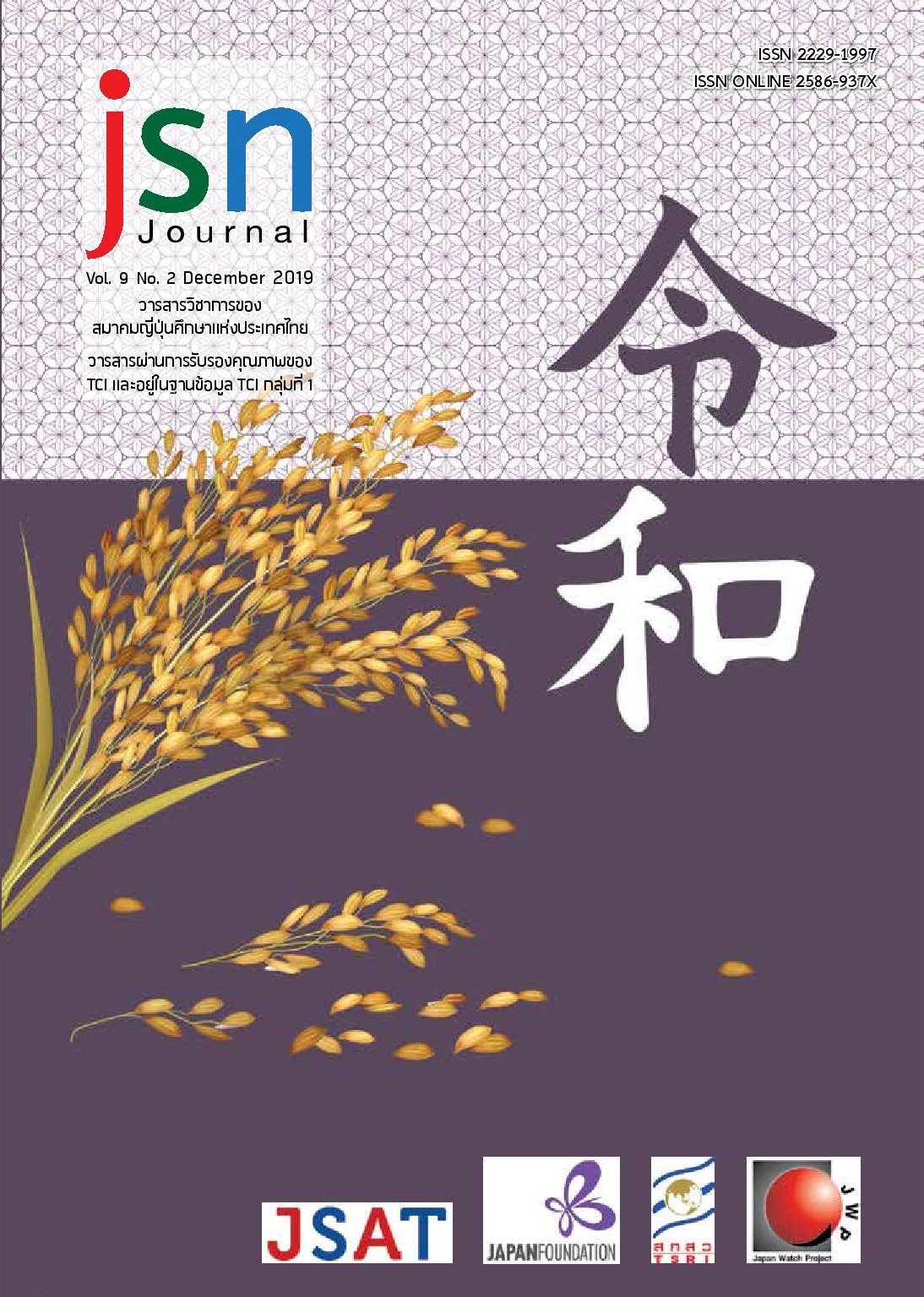A Comparison of the Acoustic Characteristics of Short and Long Vowels in Japanese Produced by Thai Learners in 3 Southern Border Provinces with Difference Mother Tongues A Case Study of Pattani Province in Thailand
Main Article Content
Abstract
The objectives of this research were to analyze and compare the acoustic characteristics of Japanese vowels pronounced by Japanese native speakers (JP) and 3 groups of Thai students with different mother tongues: Thai standard (TH), the Thai Southern dialect (ST), and the Malay dialect (ML). The first and second formant frequencies, F1 and F2 (vowel quality), and the durations (length), were studied. The sample group consisted of 6 upper secondary students with different mother tongue. The data were analyzed using the PRAAT (program).
According to the results of F1 and F2, the TH, ST, and ML students pronounced the formant frequencies of the short vowels differently from the Japanese native speakers, as with the /i/,/e/,/u/,/o/ sounds, and were significantly more peripheral. The formant frequencies of the long vowels were pronounced differently by TH, ST and ML students from the Japanese native speakers in all sounds and were significantly more peripheral. Further, the duration results indicated that —TH, ST, and ML— pronounced the short vowels longer than those pronounced by Japanese native speakers (TH > ST > ML > JP). That is, the short vowels were pronounced longer than the native speakers while the long vowels were shorter than those pronounced by Japanese native speakers (JP > ST > TH > ML). That means that the long vowels pronounced by TH were one syllable (Mora) shorter than the native speakers and this made the pronunciation fairly unnatural.
Article Details
ข้อความและข้อคิดเห็นต่างๆ ในบทความเป็นของผู้เขียนบทความนั้นๆ ไม่ใช่ความเห็นของกองบรรณาธิการหรือของวารสาร jsn Journal
References
กัญญารัตน์ เอี่ยมวันทอง. (2551). ลักษณะทางกลสัทศาสตร์ของสระในภาษามลายูถิ่นปาตานี. (วิทยานิพนธ์อักษรศาสตรมหาบัณฑิต).
ชัยยศ รองเดช. (2560). การศึกษาปัญหาการออกเสียงและการรับรู้เสียงพยัญชนะเดี่ยวภาษาญี่ปุ่นของผู้เรียนชาวไทยถิ่นใต้. (วิทยานิพนธ์ศิลปศาสตรมหาบัณฑิต).
ตามใจ อวิรุทธิโยธิน. (2553). การศึกษาลักษณะทางกลสัทศาสตร์ของพยัญชนะ สระ และวรรณยุกต์ในภาษาไทยมาตรฐานสำเนียงใต้โดยเปรียบเทียบกับภาษาไทยมาตรฐานและภาษาไทยถิ่นใต้. (วิทยานิพนธ์ดุษฎีบัณฑิต,กรุงเทพฯ:จุฬาลงกรณ์มหาวิทยาลัย).
ทัศนีย์ เมธาพิสิฐ. (2554). ภาษาศาสตร์ภาษาญี่ปุ่น. ปทุมธานี: โรงพิมพ์มหาวิทยาลัยธรรมศาสตร์.
ธนพร ศรีวุฒิพงศ์. (2559). การศึกษาประสิทธิผลการฝึกแชโดอิ้งเพื่อพัฒนาการออกเสียงสูงต่ำของคำยืมภาษาญี่ปุ่นในภาษาไทย. (วิทยานิพนธ์ศิลปศาสตรมหาบัณฑิต, มหาวิทยาลัยธรรมศาสตร์).
ธัญญารัตน์ สงวนศรี. (2554). ปัญหาการออกเสียง Yo-on (เสียงพยัญชนะควบ) ของผู้เรียนภาษาญี่ปุ่นชาวไทย. ชลบุรี: มหาวิทยาลัยบูรพา.
นิเย๊าะ จาหลง. (2556). การออกเสียงพยัญชนะภาษาญี่ปุ่นของผู้เรียนชาวไทยที่พูดภาษามลายูถิ่นปาตานีเป็นภาษาแม่. (วิทยานิพนธ์ศิลปศาสตรมหาบัณฑิต, มหาวิทยาลัยธรรมศาสตร์).
บุญเหลือ เทพยสุวรรณ, ม.ล. (2554). รวบรวมบทความเกี่ยวกับการเรียนการสอนภาษา. วารสารภาษาปริทัศน์, 26, 22-64.
ยุพกา ฟูกุชิม่า. (2561). การออกเสียงภาษาญี่ปุ่นจากทฤษฎีสู่ปฏิบัติ. กรุงเทพฯ: มหาวิทยาลัยเกษตรศาสตร์.
รัตติยา สาและ. (2552). เรียนภาษามลายูถิ่นด้วยนิทาน. สงขลา: ศูนย์หนังสือมหาวิทยาลัยทักษิณ
Yupaka Siriphonphaiboon, Isomura Kazuhiro, Pakatip Skulkru. (2008).「タイ人教師による日本語音声 教育の現状調査」『東南アジアにおける日本語 教育の展望』タマサート大学主催日本語教育国際シンポジウム発表予稿集, 146-150.
アサダーユットチューシー.(2004). 「タイ語母語話者の日本語発音に関する干渉の考察と指導提案」,『国際交流基金 バンコク日本語文化センター日本語教育紀要』第1号, 21-37.
千葉真人, 佐藤純,大田真也.(2009).「日本人教師が感じているタイ人学習者の発音の問題点とその具体例」『国際交流基金バンコク日本文化センター日本教師紀要』第6号, 115-124.
晴夫窪薗.(1998) .「モーラと音節の普遍性」『音声研究』 第2巻 第1号13号, 5-15.
河野俊之.(2014) . 『日本語教師のためのTIPS77 第3巻 音声教育の実践』くろしお出版.
皆川泰代, 前川喜久雄, 桐谷滋. (2002).「日本語学習者の長/短母音の同定におけるピッチ型と音節位置の効果」『音声研究』第6巻号, 第2, 88-97.
サウワニー スタートーンタイ.(2004).「日本語の発音における母語の影響について}タイ人日本語学習者を対象として−」,『東京:大東文化大学院外国科語学研究編』,169-175.
タサニー メーターピスィット.(2014).「タイ人日本語学習者のための音声教育の現状と課題 —教師の教育方法と学習者の取り組み方を中心に—」『早稲田日本語教育学』第16号,87-104.
戸田貴子.(1998).「モーラと中間言語の音節構造」『筑波大学留学生センター日本語教育論集』第13号,13-45


